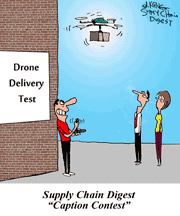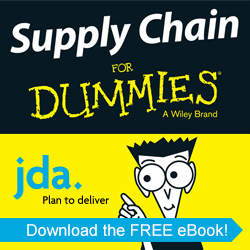Trip Report - Gartner Supply Chain Executive Conference 2015
Ok, I am thankfully at the end of the Spring conference season, after numerous straight weeks on the road. It beats me up, since I attend virtually every session available, do the daily video reviews, etc., but in the end it's really worth it because so many readers enjoy these summary reports, I learn a lot, and I gain some topic feedstock for the rest of the year.
This week, it was the Gartner Supply Chain Executive Conference in Scottsdale, AZ, and in general it was a very good event. This conference as many know is rooted in the same basic event that was started by AMR Research back in the 1990s. After Gartner acquired AMR in 2009, Gartner infused additional organizational and marketing muscle into the conference, largely to the good. I am sure the event is now much more profitable for Gartner than it ever was for AMR, with 1500+ attendees this year and an ever growing exhibitor and sponsor program. Gartner continues to get some marquee supply chain execs as speakers, though the event certainly has a much more of a "corporate" feel to it that it did in the more laid back AMR days.
| GILMORE SAYS: |
"Kern made what I think was a good point in saying that "digital" offers some hope for breakthrough gains after companies like Cisco have squeezed about all they can out of Lean, Six Sigma, outsourcing, etc."
WHAT DO YOU SAY?
Send us your
Feedback here
|
I was there for nearly two full days, and saw a number of keynote and breakout presentations. The keynotes were all very good. The breakouts again this year were a bit more hit or miss. They are of three basic types: those led by Gartner analysts, company case studies (unsponsored), and vendor-sponsored sessions ( identified as such) which may involve a customer case study or may just be delivered by vendor personnel. I saw a few good breakouts and a couple not so good, repeating a pattern from 2014.
There was a theme of sorts at the conference relative to "digitizing" your business and your supply chain - and as you may know this is one of the very hot topics of the day. Smart folks like the consultants at McKinsey and many others are telling CEOs that if they don't digitize their business starting immediately they will soon go the way of the dinosaur - as a business and personally.
That tends to get a CEO's attention, so now digitization - whatever that really is - is near the top of the corporate priority list, which naturally filters down to supply chain. The handy thing about digitization from a solution provider point of view is that it has become a broad umbrella under which a wide range of technologies have found a place: analytics, Internet of Things, mobile, visibility, trading partner integration, omni-channel commerce, and more - while noting that any old piece of software of course is a form of digitization.
That said, there is certainly something of substance here as well, even if as usual it is a bit exaggerated by the usual interested parties. Gartner's Peter Sondergaard did a good job kind of pulling all this together in his opening keynote, saying early on that virtually everything that can be "instrumented" and connected will be over the next 5 to 10 years, with hundreds of millions of such new connected things going to be added to the grid in 2015.
This and all the other main forms of digitization listed above are going to have profound effects both on businesses and the practice of supply chain, naturally enough, Sondergaard said. Among the most interesting will be the creation of new services connected to physical supply chains - as many industrial companies are already doing. Caterpillar's head of supply chain John Kern later on Tuesday morning said his company has one type of digging machine where users upload the topography of a given site, and then the blade of the machine is somehow controlled from afar via GPS. My goodness.
Sondergaard indirectly made one very interesting point: could the Internet of Things and related technologies in a sense bypass barriers to collaboration with customers? Forget data integration efforts and reluctance to share information - your connected products will just report on their own what is going on in your customer's supply chain.
He also stressed the need for "bi-modal" supply chains. Mode 1 involves traditional supply chains, focused on cost, efficiency, predictability, etc. Mode 2 is focused on the disruptive, the digital, the experimental, etc. Stodgy old chemical company BASF has formed a new group for mode 2, Sondergaard said. Will that pay off? We'll see.
After Sondergaard came Cisco's Kern. I gave him immediate credit for admitting to being an "Internet of Everything" (what Cisco calls it) skeptic not long ago, but as that would seem to be a difficult position to maintain within network systems provider Cisco, Kern says he has found IoE religion.
Kern made what I think was a good point in saying that "digital" offers some hope for breakthrough gains after companies like Cisco have squeezed about all they can out of Lean, Six Sigma, outsourcing, etc.
He offered two interesting examples. First, despite obviously a long-time focus on manufacturing quality and yield, Cisco wasn't where it wanted to be, which I assume is probably somewhere close to perfection. It has been able to take the tons of data from its manufacturing processes and apply some advanced analytics to find patterns, leading indicators and other insights it just couldn't identify with traditional techniques, leading to significant quality/yield improvements.
 Even more interestingly, Cisco has installed new sensors on every piece of equipment it has in a Malaysian factory, in an effort to better understand electricity consumption, which Kern said most companies just accept as sort of a given. Now take that monitoring and analysis to a global basis, across dozens of factories and in many regions variable rates depending on when you consume the power. Even more interestingly, Cisco has installed new sensors on every piece of equipment it has in a Malaysian factory, in an effort to better understand electricity consumption, which Kern said most companies just accept as sort of a given. Now take that monitoring and analysis to a global basis, across dozens of factories and in many regions variable rates depending on when you consume the power.
Kern believes that given this situation Cisco can save 20-30% in electricity costs using smart analytics to figure this puzzle out, an excellent examples of how "digitization" can drive breakthrough benefits.
Frank Crespo, chief procurement officer and VP of supply networks at Caterpillar, emphasized that companies must really adopt "network" thinking versus "chain" and "link' orientations, not at all a new perspective, but I think he was spot on in saying the lack of network thinking today is more common in terms of information flows than it is for product flows. He also called for more true "engineering" of the value chain, down to each individual part.
Supplier collaboration in terms of continuous improvement and innovation is something of a religion at Caterpillar, and why every company doesn't think this way I have no idea. Cat seems to have built an incredible metric system - not only can you see results for say both on-time shipments and on-time deliveries to Caterpillar factories from internal and external suppliers, but one click provides a complete breakdown of deliveries across on-time, early, delivered on time but received late, late, etc.
One more click shows root cause analysis at multiple levels relative to the failures. Do most large companies have this level of metric capability these days? I don't think so, but maybe I am behind the times. My only quibble with Crespo's presentation is that it seemed to depict s level of supply chain perfection that I suspect is not quite there even at Caterpillar, an opinion informed by other Cat presentations I have seen in recent years that spoke of many opportunities for improvement in its supply chain.
Reuben Slone of Walgreens is in the top five - if not number 1 - of currently "famous" US supply chain executives, moving to his latest spot after successful stints at OfficeMax and Whirlpool, plus Harvard Business Review articles, books, etc. I have always viewed him as a "cerebral" type - a thinking man's CSCO - and he is that for sure, but showed a bit of "heart" as well as "head" in his excellent presentation.
Slone said supply chains need to be focused on three "outcomes." It starts with appropriate product availability - that drives revenue and sales growth. But then that product availability needs to be achieved with maximum inventory productivity (cash flow) and cost productivity (margins).
If you achieve those outcomes, "economic profits" and thus shareholder value will increase. More on all this soon. On the "heart" side, Slone gave a powerful update on Walgreen's highly successful program to hire disabled workers at its distribution centers, an initiative started by former logistics VP Randy Lewis. Excellent results - why aren't more doing this?
So much more, but I am out of space - look for a part 2 soon, including a great breakout presentation from Dell/E2open on multi-tier visibility.
Any reaction to the issues or insight ? Let us know your thoughts at the Feedback button or section below. |












